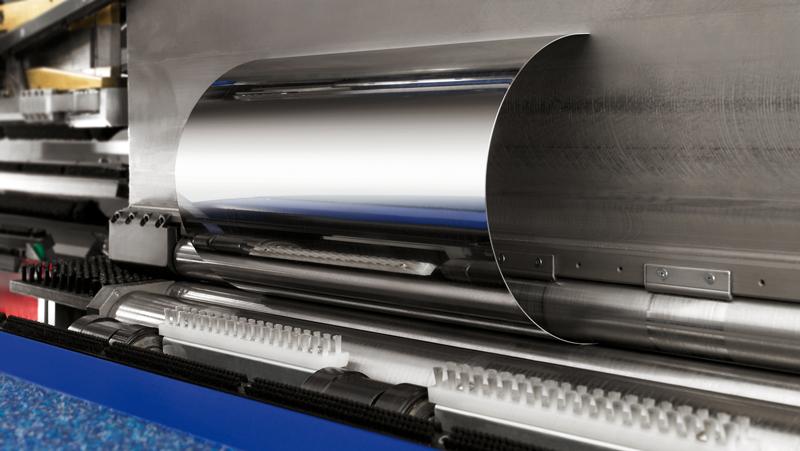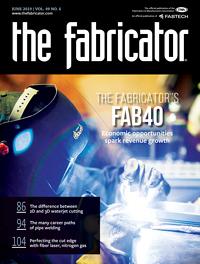Senior Editor
- FMA
- The Fabricator
- FABTECH
- Canadian Metalworking
Categories
- Additive Manufacturing
- Aluminum Welding
- Arc Welding
- Assembly and Joining
- Automation and Robotics
- Bending and Forming
- Consumables
- Cutting and Weld Prep
- Electric Vehicles
- En Español
- Finishing
- Hydroforming
- Laser Cutting
- Laser Welding
- Machining
- Manufacturing Software
- Materials Handling
- Metals/Materials
- Oxyfuel Cutting
- Plasma Cutting
- Power Tools
- Punching and Other Holemaking
- Roll Forming
- Safety
- Sawing
- Shearing
- Shop Management
- Testing and Measuring
- Tube and Pipe Fabrication
- Tube and Pipe Production
- Waterjet Cutting
Industry Directory
Webcasts
Podcasts
FAB 40
Advertise
Subscribe
Account Login
Search
Tackling a growth market with precision tubes
The transformation of York Metal Products with precision-diameter tubing
- By Tim Heston
- May 31, 2019
- Article
- Tube and Pipe Fabrication
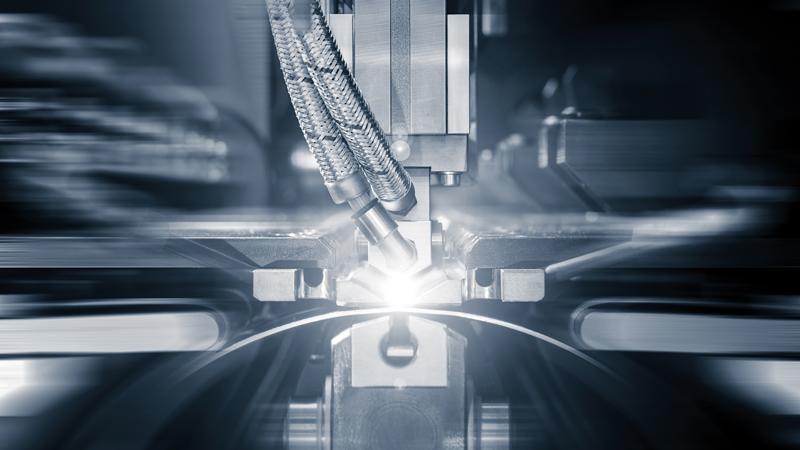
A fiber laser welds a precision-rolled cylinder. The rolling and welding occur in one machine. York Metal Products has integrated two such machines from Weil for forming precision exhaust and similar components. Photo courtesy of Weil Engineering North America.
York Metal Products has a history in the metal spinning business that goes back to the late 1940s. When Doug Paulson, a mechanical engineer, bought the company in 2000, the Concord, Ont.-based company had a solid customer base and employed some serious spinning talent. And it still does today, but it’s also a very different company. It goes back to a strategic shift York’s leadership made after emerging from the recession 10 years ago.
After Paulson purchased the business in 2000, York added more CNC spinning machines, along with punching, braking, welding, and assembly. All this helped the company grow from $1.8 million in sales in 2000 into a $5.9 million company in 2007.
Then came the economic downturn of 2008 and 2009. When many of York’s customers closed their Canadian operations, annual sales plunged to less than $4.0 million. York’s leaders knew it was time for a change. It was time for new leadership.
Enter Dave Myers and Guy Cavallini, two former automotive executives, along with a few of their associates who expressed interest in leading the business. They had a carefully researched plan for growth, one that would help take the company in a new direction. They wanted to add precision-diameter cylindrical and tubular manufacturing with value-added forming operations.
The Limits of Spinning
After so many decades in the business, York had become well-known in metal spinning circles. The metal spinning process—in which rollers move back and forth to form a disk over a spinning mandrel—was perfect for difficult parts that just couldn’t be formed cost-effectively any other way at a given quantity. For many geometries, a CNC spinning machine could churn out more than 40 parts an hour. That was fast for spinning, but extremely slow for stamping.
“Those same pieces often could be stamped at several thousand parts per hour,” said Paulson, who today is York’s vice president of engineering. “So quite often, as the volume of parts became greater, metal spinning wasn’t cost-effective, and we often lost the job.”
To compete in new markets, the company’s new leaders knew they couldn’t simply ramp up production by producing more cylinders and tubes like it had before. Being in the spinning business, the shop had manually rolled, welded, and spun plenty of medium- to large-diameter cylinders and tubes over the years. But the occasional sloppy weld on the longitudinal seam caused problems. Weld times were sometimes as long as 20 minutes for a single cylinder.
Even the worst-looking weld still could be structurally sound, but not if that cylinder needed to go into a spinning machine. And even if the weld wasn’t ugly, it still could cause problems if it wasn’t just right. “Metal spinning is a highly aggressive process, with the [forming rollers] moving in and out,” Paulson said. “If there are any flaws in the weld, it creates a big problem. We would have very high reject rates.”
The New Growth Market
While CNC metal spinning works well for forming some shapes into cylindrical containers, it doesn’t work at all for applications in certain markets, including a major one York was targeting: precision-diameter cylinders and tubes for the diesel particulate filter (DPF) for exhaust systems on commercial trucks. DPF cylinders have inside diameters (IDs) made to a precise dimension that optimizes engine performance and exhausts gas flow in accordance with the engine producer’s specifications.
The DPF design calls for IDs in odd sizes, like 10.420 inches, and the closest common ID would be 10 or 11 in., which just wouldn’t work. The DPF media that cleans the exhaust is very rigid and brittle, and the filter construction demands a precise fit.
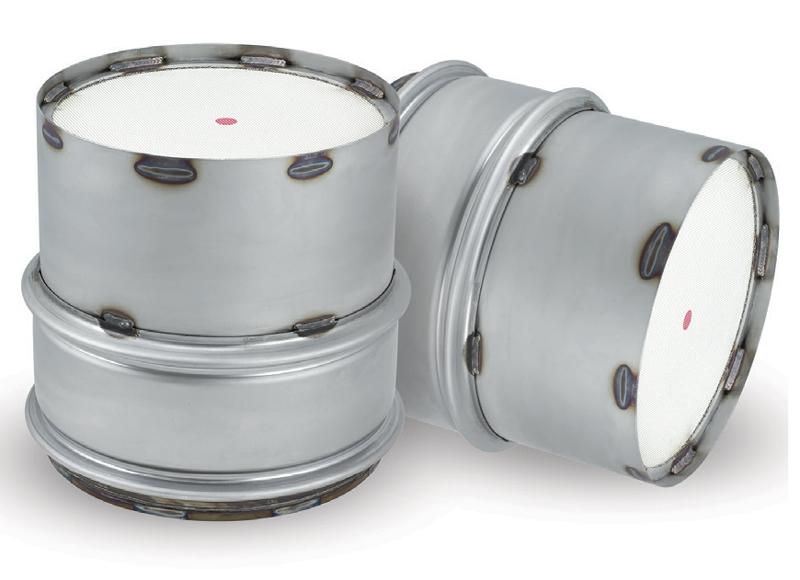
To form components for the diesel particulate filter (DPF), York Metal Products rolls and laser-welds the cylinder in a multiroll forming and welding system from Weil, then sends it through the 3D flow forming process, which York licenses from a company in Germany. Photo courtesy of Global Emissions Systems Inc.
“When we were thinking about entering this market, we saw that there were few, if any, competitors that were able to provide the tight tolerance associated with these parts, especially because these parts are very round with little or no flat section,” said Myers, who now serves as York’s president.
Conventional sheet and plate rolling machines need an unbent flat section to grasp the workpiece. Prebending the workpiece edge in a brake or in the roll itself minimizes the flat section. But for these precision-ID applications, minimizing the flat the conventional way just wasn’t good enough. The ID has an extremely narrow tolerance window.
York needed a way to roll cylinders and tube such that the edges would butt together, ready to be joined by a precision process that, again, had extremely high weld integrity and consistent joint geometry. Even a small protrusion of weld extending below the butt joint could throw the ID out of tolerance.
To overcome this challenge, the York team turned to an unusual rolling technology: a multiroll bending and welding system from Weil Engineering North America. York had purchased its first machine to make complex cylindrical aluminum air valves for a customer in Quebec. Seeing how the machine performed in that application, York’s technical team began using it to make DPFs.
The machine operates by a bending principle that’s different from a typical rolling machine. The rollers move in multiple axes. The blank is pushed over a series of bottom rollers, after which the upper roller (which from the side resembles a window punch of a press brake) descends. The rolls move in Z (up and down) and Y (side to side) per the bend program to produce a precise cylinder or other rolled shape.
Once the cylinder edges meet, a push-out unit carries the formed cylinder to another station, where the workpiece is secured and welded, either by laser beam or gas tungsten arc welding.
In York’s DPF application, precut (and often prepunched) 430 stainless steel blanks of different thicknesses (such as 0.036 in.) are fed into the CNC multiroll system, which rolls them to a specified diameter between 6 and 14 in., depending on the product. The multiroll can roll tubes and cylinders from 3 to 24 in. diameter, working with material up to 0.100 in. thick, depending on the material grade and final rolled shape, which can be up to 47 in. long.
For 430 stainless products like the DPF, York uses the rolling system’s laser welding capability. Today York has two of these multiroll-bending and welding machines from Weil, and both use fiber laser technology.
Enter 3D Flow Forming
When York integrated the rolling-welding system in 2012, the formed DPF cylinders went on to a CNC spinning machine. But with the success of the DPF cylinder project and subsequent jobs, customers started asking York about other parts it could do, one of them being the end forms that connect the DPF with the overall exhaust system.
However, that end-form piece couldn’t be produced with metal spinning, mainly because of the limited material thinning requirements. To remedy this, York made these parts from short precision cylinders that could be fixtured onto the spinning lathe and subsequently formed with an acceptable amount of thinning. They then had to be welded onto the main precision-diameter cylinder. Unfortunately, all this took a fair amount of time.
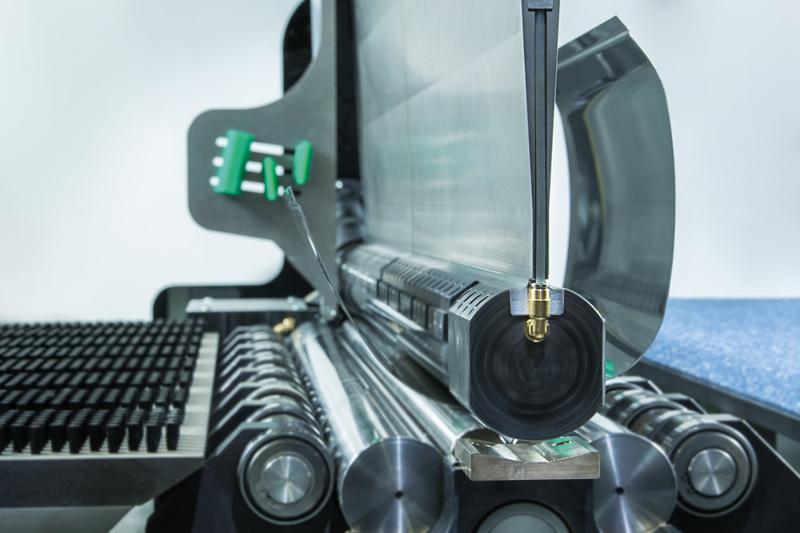
The multiroll bending machine uses a series of rollers to form various shapes, including cylindrical shapes with no perceptible flat. York’s setup has a window above the upper roller (roughly analogous to a window in a press brake punch tool) that allows 360 degrees of forming. Photo courtesy of Weil Engineering North America.
“The problem with spinning was that it wasn’t a very efficient process,” Myers recalled, “mainly because the application called for a fair number of slow, tedious spinning operations just to make the two end forms for one cylinder. This was followed by a considerable amount of fitting and welding to make the final product.”
The end-form shapes were complex, and York didn’t have the equipment to spin them in one piece. Sure, York’s spinning techs have found ways to spin such parts. Basic shapes could be spun “in air,” without a mandrel, but this wasn’t an option for this precision part. For more complex shapes, they sometimes used “jigsaw tooling” mandrels that could be added and removed midway through spinning. But that prolonged the cycle time and made for a very complex, costly process. The team knew there had to be a better way.
To find it, Myers reached out to Weil in Germany, which in turn led to another German company, MetaForm, entering the picture. That company was using Weil’s multiroll technology with a rare process called 3D flow forming. The process incorporates a series of rollers that contact and form the material over both the ID and outside diameter (OD) of the workpiece. Each roller is highly controlled, and each can move in three axes, not just two.
Advanced programming controls the rollers in such a way that provides consistent pressure through each forming operation. And when the ID rollers retract inward, the formed part can be removed, even if the part’s diameter on the ends is smaller than the diameter in the middle.
“The series of rollers, inside and out, work in concert to create the shape,” Myers said, adding that “3D flow forming moves material quite differently than metal spinning.”
York has licensed that 3D flow forming technology and now is using the machine to form the end-form exhaust component out of one piece and with minimal wall thinning, between 10 and 15 percent. And today the company also uses 3D flow forming to produce DPFs with the required complex geometry end forms built right into the cylinder—delivered to the customer all in one piece.
Gary Jarosz, vice president of York’s customer for the DPFs, Whitby, Ont.-based Global Emissions Systems Inc., recalled learning about 3D flow forming from York’s engineers and immediately realizing its potential. He explained that “we were about to reduce the number of components for a typical DPF by 50 percent or more.” The product also requires much less welding and much less overall manufacturing time.
Precision Upstream, Repeatability Downstream
Each manufacturing step at York depends on the accuracy of the previous step. Consider the DPF, the project that started York’s transformation six years ago. It’s 3D flow-formed to a tight tolerance, which requires the cylinder itself to be welded to within a tight tolerance. A near-perfect weld needs a near-perfect fit-up and repeatable material chemistry. This in turn requires a rolling procedure that forms the cylinder just the right amount at just the right diameter, with the rolling program accounting for the prepunched holes and, not least, variations between material heats.
The company runs high-quality material, and technicians usually don’t need to make any adjustments within the same heat. But between heats, thickness and hardness variations can change the rolling characteristics slightly, which is why technicians follow a procedure with every new material heat. They measure the material thickness, run a test part, and adjust the roll program as necessary. They check the weld integrity and measure the cylinder diameter on a coordinate measuring machine.
In many ways this is light-years away from York’s spinning job shop of the 1940s and 1950s. The spinners decades ago probably couldn’t have imagined the shop’s technology now, not just the rolling, laser welding, and 3D flow forming, but other processes the company has brought in-house as well, including 5-axis laser cutting.
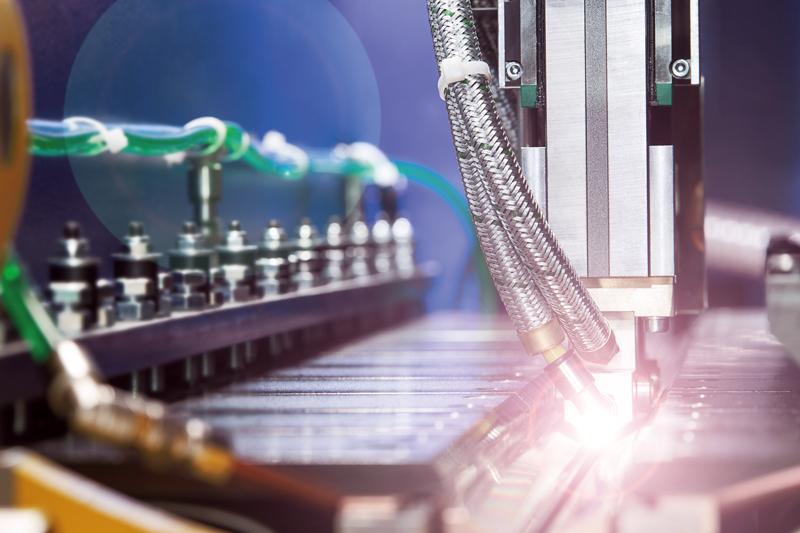
The multiroll bending and welding machine can operate with a fiber laser (shown) or another joining process like gas tungsten arc welding. Photo courtesy of Weil Engineering North America.
“We were concerned that the future of this growing market was limited,” Paulson said. “A MaRS research study showed that this market is going to be strong through 2040.” Battery technology has a very long way to go before it can compete with the energy efficiency of a commercial truck’s diesel engine, except perhaps for short hauls.
As a metal spinner, York’s growth curve was flat. As a fabricator of precision-diameter rings, cylinders, and complex cylinders, York’s growth curve looks to be headed upward for decades to come.
About the Author

Tim Heston
2135 Point Blvd
Elgin, IL 60123
815-381-1314
Tim Heston, The Fabricator's senior editor, has covered the metal fabrication industry since 1998, starting his career at the American Welding Society's Welding Journal. Since then he has covered the full range of metal fabrication processes, from stamping, bending, and cutting to grinding and polishing. He joined The Fabricator's staff in October 2007.
Related Companies
subscribe now

The Fabricator is North America's leading magazine for the metal forming and fabricating industry. The magazine delivers the news, technical articles, and case histories that enable fabricators to do their jobs more efficiently. The Fabricator has served the industry since 1970.
start your free subscription- Stay connected from anywhere

Easily access valuable industry resources now with full access to the digital edition of The Fabricator.

Easily access valuable industry resources now with full access to the digital edition of The Welder.

Easily access valuable industry resources now with full access to the digital edition of The Tube and Pipe Journal.
- Podcasting
- Podcast:
- The Fabricator Podcast
- Published:
- 04/16/2024
- Running Time:
- 63:29
In this episode of The Fabricator Podcast, Caleb Chamberlain, co-founder and CEO of OSH Cut, discusses his company’s...
- Trending Articles
AI, machine learning, and the future of metal fabrication

Employee ownership: The best way to ensure engagement

Steel industry reacts to Nucor’s new weekly published HRC price

Dynamic Metal blossoms with each passing year

Metal fabrication management: A guide for new supervisors

- Industry Events
16th Annual Safety Conference
- April 30 - May 1, 2024
- Elgin,
Pipe and Tube Conference
- May 21 - 22, 2024
- Omaha, NE
World-Class Roll Forming Workshop
- June 5 - 6, 2024
- Louisville, KY
Advanced Laser Application Workshop
- June 25 - 27, 2024
- Novi, MI
























